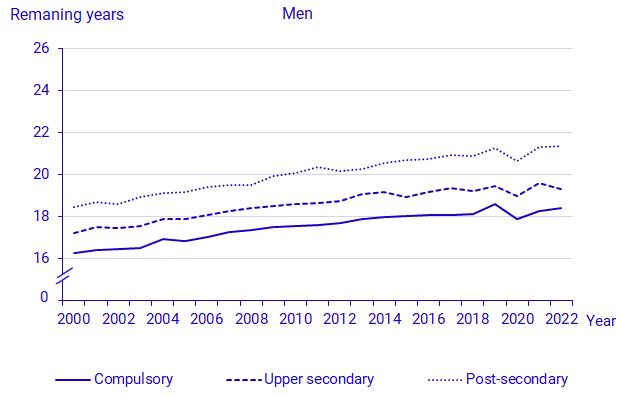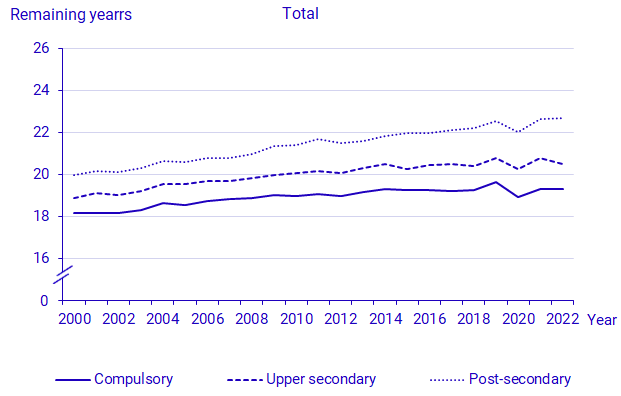Life expectancy at age 65 by educational attainement 2000-2022



Comments
In 2022 remaining life expectancy at 65 years was 20.7 years for both sexes taken together. That is 2.2 years more than in 2000. In other words, average life expectancy has increased considerably among older persons in the period 2000–2022. The figure shows that the number of years of remaining life expectancy has increased for all groups regardless of the level of education.
However, there are clear differences between the groups. In 2022, for the group with post-secondary education the number of years of remaining life expectancy at 65 years was 23.9 years for women and 21.4 years for men. For the group with compulsory education, the number of expected years remaining was 20.3 years for women and 18.4 years for men. For the group with post-secondary education, the number of expected years remaining at 65 years was 3.6 years more (for women) and 3.0 years more (for men) than for those in the group with compulsory education. For both sexes this was a somewhat larger difference than in 2020.
Due to the high mortality from COVID-19, remaining life expectancy at 65 years dropped for both women and men in 2020, regardless of the level of education. In 2021, life expectancy at 65 years increased for both sexes. Between 2021 and 2022, life expectancy developed differently for different groups. Life expectancy decreased for women of all educational levels. The largest decrease was seen for women with upper secondary education, 0.3 years. Life expectancy for men with compulsory education and post-secondary education somewhat increased while that for men with upper secondary decreased by 0.3 years.
In the period 2010–2022, average remaining life expectancy at 65 years increased more for women and men with a post-secondary education than for the groups with upper secondary education and with compulsory education. The increase in average life expectancy between 2010 and 2022 was 1 year for women with post-secondary education, for women with upper secondary education it increased by 0.2 years. For women with compulsory education life expectancy in 2022 was at almost the same level of 2010. This means that women with the highest level of education have widened the gap in average life expectancy to other groups in recent years. A similar development was noted for men. For men, life expectancy at 65 years increased by 0.9 years between 2010 and 2022 for those with compulsory education, by 0.7 years for those with upper secondary education and by 1.3 years for those with post-secondary education.
The calculation of remaining life expectancy by level of education only includes persons born in Sweden. Data on the level of education is often not available for foreign born persons, which is why they have been excluded from this statistic in the graphs. The calculation of life expectancy is smoothed for death risks in the highest ages, 90 years and older, for 2000–2009, and 99 years and older for 2010–2011. The smoothing in 2000–2011 means that all groups of education are allotted the same death risk as women and men born in Sweden in total in the country as from the various high ages. The reason for this smoothing is that the level of education is not available for anyone born in Sweden before 1911. As from 2012, the same calculation is used as in the official statistics for women and men in total in Sweden.